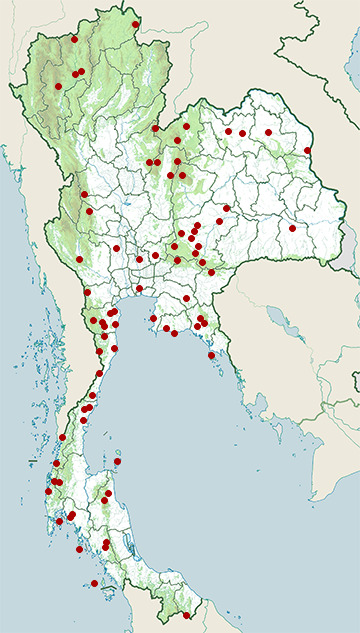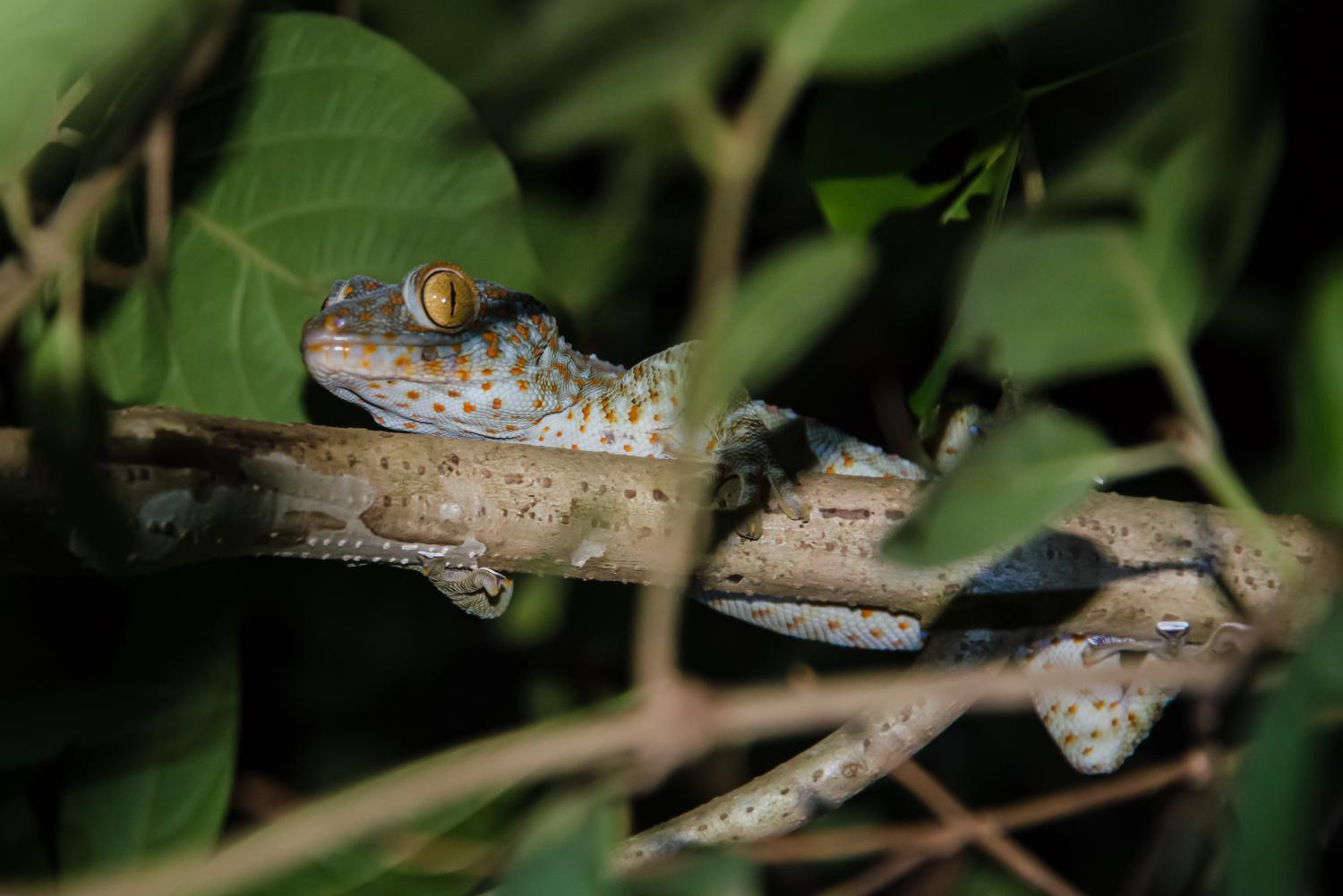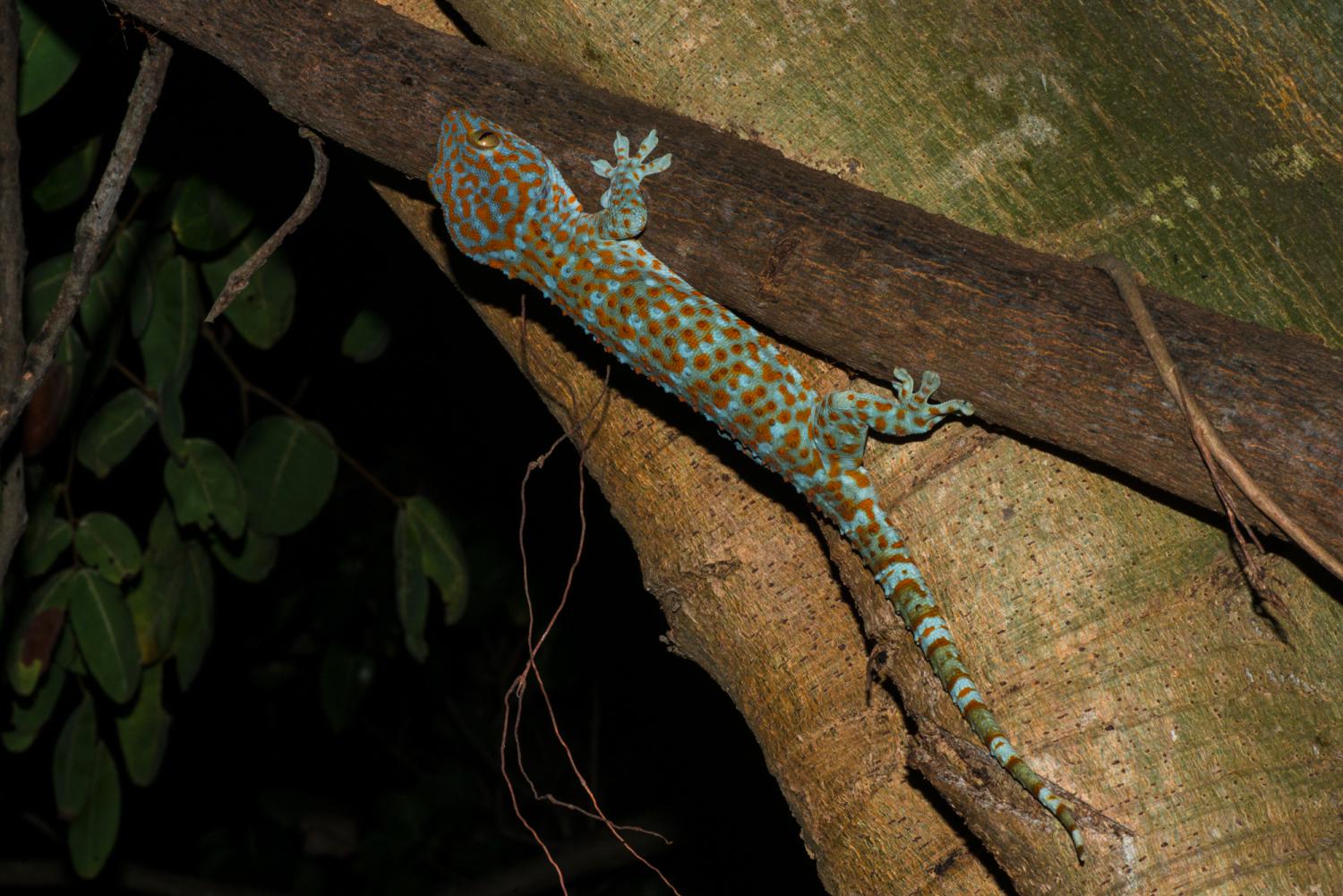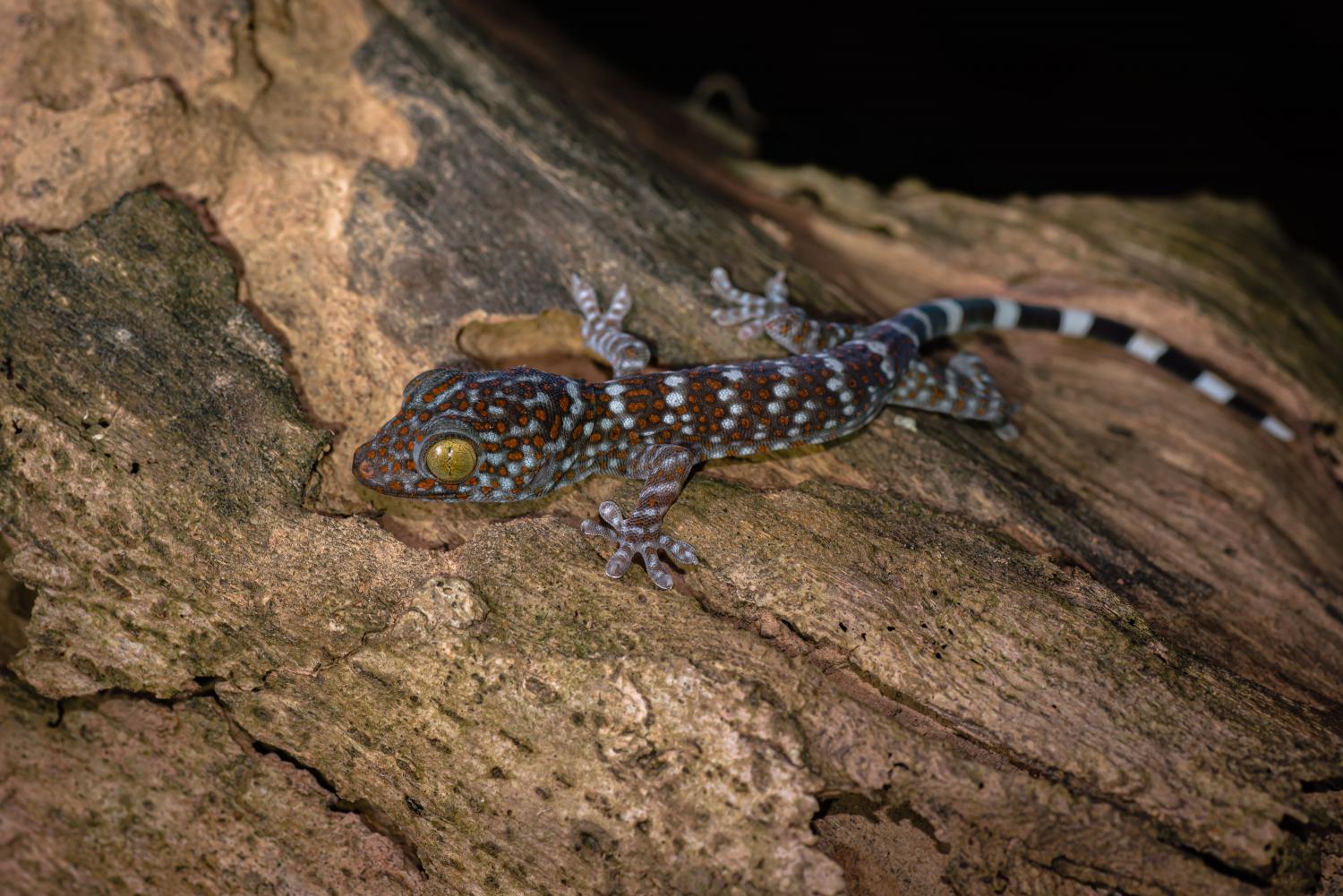Species of Thailand
Common tokay gecko
Gekko gecko
Carolus Linnaeus, 1758
In Thai: ตุ๊กแกบ้าน, took gaeh baan
The tokay gecko (Gekko gecko) is a nocturnal arboreal gecko, ranging from northeast India, Bhutan, Nepal, Bangladesh, throughout Southeast Asia, Philippines to Indonesia and western New Guinea. Its native habitat is rainforest trees and cliffs, and it also frequently adapts to rural human habitations, roaming walls and ceilings at night in search of insect prey. Increasing urbanization is reducing its range.
The tokay gecko is known as a hokkeng in Chakma, takshak in Bengali, hankkok in Manipuri, tuko in the Philippines, tokkae in Malaysia, tokek in Indonesian/Javanese, tắc kè in Vietnamese, kokkek in Zomi and ตุ๊กแก {{IPA|in Thai, Sawk-khe in HMAR and awke in Mizo for its characteristic vocalizations.
Physical characteristics and behaviour
The Tokay Gecko is the second largest Gecko species, attaining lengths of about 11 - 20 cm for males, and 7 - 19 cm for females, with weights of only 150 – 400 g. They are distinctive in appearance, with a bluish or grayish body, sporting spots ranging from light yellow to bright red. The male is more brightly colored than the female. They have large eyes with a vertical slit pupil. Eyes are brown to greenish brown and can be orange or yellow.
Males are very territorial, and will attack other male Tokays as well as other Gecko species, as well as anything else in their territory. Females lay clutches of one or two hard shelled eggs which are guarded until they hatch. Tokay Geckos feed on insects and small vertebrates. Their strong bite is needed to crack the shell of hard cockroaches that live in the rainforests. They are also extremely strong climbers and their foot pads can support their entire weight on a vertical surface for a long amount of time without any effort. Compared to other gecko species, the Tokay has a robust build, with a semi-prehensile tail, a large head and muscular jaws; though common in the pet trade, Tokays are reputed to be capable of inflicting a painful bite, making them ill-suited for inexperienced keepers.
Call
Their mating call, a loud croak, is variously described as sounding like token, gekk-gekk or poo-kay where both the common and the scientific name (deriving from onomatopoeic names in Malay, Sundanese, Tagalog, Thai, or Javanese), as well as the family name Gekkonidae and the generic term gecko come from. The call is similar to the call made by Gekko smithii (Large Forest Gecko).
The gecko's call is also responsible for a slang name given to it by U.S. soldiers during the Vietnam War: the fuck-you lizard.
Conservation
Tokay geckos are culturally significant in many East Asian countries. Regional folklore has attributed supernatural powers to the gecko. Examples of such myths are the belief that they are harbingers of good luck, that they can see into the future, and that they are the descendants of dragons.
The Tokay gecko is also an ingredient in Traditional Chinese medicine known as Ge Jie (蛤蚧). Tokay geckos are in high demand herb believed to tonify kidney (yang energy), nourish kidney essence, tonify lung, and relieve cough and dyspnea. These beliefs are not substantiated by medical science. They remain highly sought after in in China, Hong Kong, Taiwan, Vietnam, Malaysia, Singapore and other parts of Asia with Chinese communities, to the point where unscrupulous merchants have taken to modifying monitor lizards with prosthetics to pass them off as colossal Tokay gecko specimens.
The tokay gecko is quickly becoming a threatened species in the Philippines due to indiscriminate hunting. Collecting, transporting and trading in geckos without a license can be punishable by up to twelve years in jail and a fine of up to Php 1, 000, 000.00 under Republic Act 9147 in addition to other applicable international laws. However, the trade runs unchecked due to the sheer number of illegal traders and reports of lucrative deals. Chinese buyers and other foreign nationals are rumored to pay thousands of dollars for large specimens, because of their alleged medicinal value or as commodities in the illegal wildlife trade.
Tokay geckos are frequently traded for medicinal purposes in Vietnam and China.
Tokay geckos are naturalized with breeding populations in South Florida.
Subspecies
Two subspecies are currently recognized.
- G. g. gecko (Linnaeus, 1758): tropical Asia from northeastern India to eastern Indonesia.
- G. g. azhari Mertens, 1955: found only in Bangladesh.
This article uses material from Wikipedia released under the Creative Commons Attribution-Share-Alike Licence 3.0. Eventual photos shown in this page may or may not be from Wikipedia, please see the license details for photos in photo by-lines.
Scientific classification
- Kingdom
- Animalia
- Phylum
- Chordata
- Class
- Reptilia
- Order
- Squamata
- Suborder
- Lacertilia
- Family
- Gekkonidae
- Genus
- Gekko
- Species
- Gekko gecko
Common names
- German: Tokeh
- English:
- Common tokay gecko
- Tokay gecko
- Tuctoo
- Thai:
- ตุ๊กแกบ้าน, took gaeh baan
- ตุ๊กแก, took gaeh
Subspecies
Gekko gecko azhari, Robert Mertens, 1955
Gekko gecko gecko, Carolus Linnaeus, 1758
Conservation status

Near Threatened
Photos
Please help us review our species pages if wrong photos are used or any other details in the page is wrong. We can be reached via our contact us page.
Range Map

- Ban Lat District, Phetchaburi
- Bang Lamung District, Chonburi
- Bang Saphan Noi District, Prachuap Khiri Khan
- Cha-Am District, Phetchaburi
- Doi Inthanon National Park
- Doi Saket District, Chiang Mai
- Don Chedi District, Suphan Buri
- Erawan National Park
- Hala-Bala Wildlife Sanctuary
- Hua Hin District, Prachuap Khiri Khan
- Huai Kha Khaeng Wildlife Sanctuary
- Huai Yang Waterfall National Park
- Kaeng Krachan District, Phetchaburi
- Kaeng Krachan National Park
- Kapo Waterfall Forest Park
- Kham Thale So District, Nakhon Ratchasima
- Khao Khitchakut District, Chanthaburi
- Khao Khitchakut National Park
- Khao Kho District, Phetchabun
- Khao Laem Ya - Mu Ko Samet National Park
- Khao Luang National Park
- Khao Nan National Park
- Khao Phanom Bencha National Park
- Khao Sam Roi Yot National Park
- Khao Sok National Park
- Khao Yai National Park
- Khlong Nakha Wildlife Sanctuary
- Ko Chang National Park
- Ko Lanta National Park
- Ko Samui District, Surat Thani
- Ko Yao District, Phang Nga
- Kui Buri National Park
- Lam Nam Kra Buri National Park
- Mae Wong National Park
- Mueang Chiang Mai District, Chiang Mai
- Mueang Chumphon District, Chumphon
- Mueang Krabi District, Krabi
- Mueang Loei District, Loei
- Mueang Phetchaburi District, Phetchaburi
- Mueang Rayong District, Rayong
- Mueang Sisaket District, Sisaket
- Mueang Udon Thani District, Udon Thani
- Na Yong District, Trang
- Nam Nao National Park
- Namtok Sam Lan National Park
- Non Thai District, Nakhon Ratchasima
- Nong Han District, Udon Thani
- Pak Chong District, Nakhon Ratchasima
- Pak Thong Chai District, Nakhon Ratchasima
- Pang Sida National Park
- Pathio District, Chumphon
- Pha Daeng National Park
- Phang Khon District, Sakon Nakhon
- Phimai District, Nakhon Ratchasima
- Phra Nakhon Si Ayutthaya District, Phra Nakhon Si Ayutthaya
- Phra Pradaeng District, Samut Prakan
- Phu Khiao Wildlife Sanctuary
- Phu Luang Wildlife Sanctuary
- Phu Suan Sai National Park
- Prathai District, Nakhon Ratchasima
- Sakaerat Environmental Research Station
- Sikhio District, Nakhon Ratchasima
- Sri Phang-nga National Park
- Suan Phueng District, Ratchaburi
- Sung Noen District, Nakhon Ratchasima
- Takua Pa District, Phang Nga
- Tarutao National Marine Park
- Tat Mok National Park
- Tha Mai District, Chanthaburi
- Tha Takiap District, Chachoengsao
- Tha Yang District, Phetchaburi
- Thap Lan National Park
- That Phanom District, Nakhon Phanom
- Thung Salaeng Luang National Park
- Wiang Kaen District, Chiang Rai
- Yan Ta Khao District, Trang


